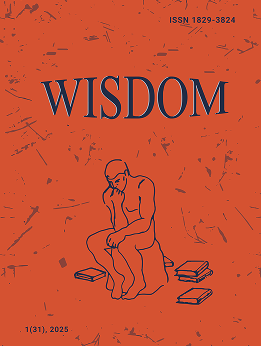New Nakhichevan Dialect as an Element of the Armenian National Identity
DOI:
https://doi.org/10.24234/wisdom.v3i2.862Keywords:
New Nakhichevan dialect, identity, semantics, foreignism, purism, Russophilia, bilingualismAbstract
The formation of the Armenian Diaspora was specifically crucial for the Armenian people and the Armenian language. Armenians worldwide have expanded the range of the Armenian language, exerting great efforts to preserve the integrity of the language. Conditioned by this, one noticeable problem for the literary language has emerged; as much as foreignisms are dangerous for the language, purisms are equally dangerous.
The article is dedicated to one of the critical elements of self-determination of Armenians living in the region of New Nakhichevan; the current language status of the Armenian dialect, the scope of its use and the preservation of the national face through language.
In order to avoid the danger of assimilation, especially the representatives of the Western dialect group create Armenian morphemes and try to translate all the words indiscriminately, even internationally acceptable terms, which signals the fear living in the subconscious that the distortion of the language will lead to the distortion of the national identity.
Dialects also evince features in semantics. In the article, we have presented several words used in the dialect, which, compared to other Armenian dialects, coincide in terms of expression but differ in terms of content.
Downloads
References
Acharyan, H. (1925). Qnnut’yun Nor Nakhijevani (Khrimi) barbari (Study of New Nakhichevan (Khrim) dialect, in Armenian). Retrived from https://bit.ly/3onw16I
Bozoyan, Y. (1995). Azgayin inknutyunn u inqnagitakcut’yuny 21-rd dari shemin (National identity and self-awareness at the threshold of the 21st century, in Armenian). Inknutyun (Identity, in Armenian), 26-37. Retrived from https://bit.ly/3RWaEXC
Demirchyan, M. (2018). Azgayin inknutyuny jhamanakakic arjhekayin phokhakerpumneri hamate-kstum (National identity in the context of modern value transformations, in Armenain). Retrived from https://bit.ly/3okS3qL
Gharibyan, A. (1953). Hay barbaragitutyun: Hnchyunabanutyun ev Dzevabanutyun, (Armenian dia-lectology: Phonetics and morphology, in Armenian). Yerevan: HSSR Her. Pet. Mank. In-t.
Harutyunyan, E. (2019). Azgayin inknutyun: “Serundneri ashkharh” ev “Jhamanakakicneri ash-kharh” (National identity. “World of generations” and “World of modern men”, in Armeni-an. Retrived from https://bit.ly/3BbC8mi
Jahukyan, G. (1972). Hay barbaragityan neratsut’yun (Introduction to Armenian dialectology, in Armenian). Yerevan: HSSH GA.
Jalashyan, G. (2018). Nor Nakhijevani batsatrakan bararan (New Nakhichevan explanatory diction-ary, in Armenian). Doni Rostov: Terra Don.
Hayoc lezvi barbaryin bararan (A dialect dictionary of the Armenian language, in Armenian). (2001-2012). Language Institute named after Hrachya Acharyan. Retrived from https://bit.ly/3S6lo6b
Mkrtchyan, G. (2015). Barbaragitutyan himunkner (dasakhosutyunner) (Basics of dialectology (lec-tures), in Armenian). Retrived from https://bit.ly/3RX7yCW
Neiburg, F. (2001). International Encyclopedia of the Social & Behavioral Sciences. National Charac-ter. Retrived from https://bit.ly/3yUPQHs
Voskanyan, A. (1995). Azgayin inknutyan himnaharcy ev mtavorakanutyan kochumy (The issue of national identity and the calling of the intelligentsia, in Armenian). Inknutyun (Identity, in Armenian), 11-20. Retrived from https://bit.ly/3RWaEXC
Downloads
Published
How to Cite
Issue
Section
Categories
License
Copyright (c) 2022 scientific journal WISDOM

This work is licensed under a Creative Commons Attribution-NoDerivatives 4.0 International License.
Creative Commons Attribution-Non-Commercial (CC BY-NC). CC BY-NC allows users to copy and distribute the article, provided this is not done for commercial purposes. The users may adapt – remix, transform, and build upon the material giving appropriate credit, and providing a link to the license. The full details of the license are available at https://creativecommons.org/licenses/by-nc/4.0/.















